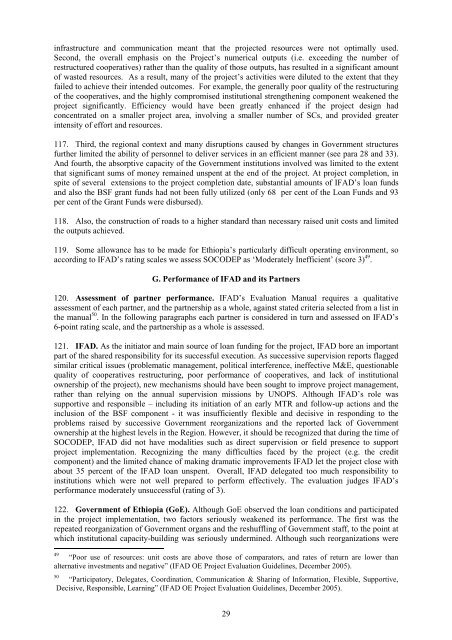Ethiopia SOCODEP CE - main report - IFAD
Ethiopia SOCODEP CE - main report - IFAD
Ethiopia SOCODEP CE - main report - IFAD
You also want an ePaper? Increase the reach of your titles
YUMPU automatically turns print PDFs into web optimized ePapers that Google loves.
infrastructure and communication meant that the projected resources were not optimally used.<br />
Second, the overall emphasis on the Project’s numerical outputs (i.e. exceeding the number of<br />
restructured cooperatives) rather than the quality of those outputs, has resulted in a significant amount<br />
of wasted resources. As a result, many of the project’s activities were diluted to the extent that they<br />
failed to achieve their intended outcomes. For example, the generally poor quality of the restructuring<br />
of the cooperatives, and the highly compromised institutional strengthening component weakened the<br />
project significantly. Efficiency would have been greatly enhanced if the project design had<br />
concentrated on a smaller project area, involving a smaller number of SCs, and provided greater<br />
intensity of effort and resources.<br />
117. Third, the regional context and many disruptions caused by changes in Government structures<br />
further limited the ability of personnel to deliver services in an efficient manner (see para 28 and 33).<br />
And fourth, the absorptive capacity of the Government institutions involved was limited to the extent<br />
that significant sums of money re<strong>main</strong>ed unspent at the end of the project. At project completion, in<br />
spite of several extensions to the project completion date, substantial amounts of <strong>IFAD</strong>’s loan funds<br />
and also the BSF grant funds had not been fully utilized (only 68 per cent of the Loan Funds and 93<br />
per cent of the Grant Funds were disbursed).<br />
118. Also, the construction of roads to a higher standard than necessary raised unit costs and limited<br />
the outputs achieved.<br />
119. Some allowance has to be made for <strong>Ethiopia</strong>’s particularly difficult operating environment, so<br />
according to <strong>IFAD</strong>’s rating scales we assess <strong>SOCODEP</strong> as ‘Moderately Inefficient’ (score 3) 49 .<br />
G. Performance of <strong>IFAD</strong> and its Partners<br />
120. Assessment of partner performance. <strong>IFAD</strong>’s Evaluation Manual requires a qualitative<br />
assessment of each partner, and the partnership as a whole, against stated criteria selected from a list in<br />
the manual 50 . In the following paragraphs each partner is considered in turn and assessed on <strong>IFAD</strong>’s<br />
6-point rating scale, and the partnership as a whole is assessed.<br />
121. <strong>IFAD</strong>. As the initiator and <strong>main</strong> source of loan funding for the project, <strong>IFAD</strong> bore an important<br />
part of the shared responsibility for its successful execution. As successive supervision <strong>report</strong>s flagged<br />
similar critical issues (problematic management, political interference, ineffective M&E, questionable<br />
quality of cooperatives restructuring, poor performance of cooperatives, and lack of institutional<br />
ownership of the project), new mechanisms should have been sought to improve project management,<br />
rather than relying on the annual supervision missions by UNOPS. Although <strong>IFAD</strong>’s role was<br />
supportive and responsible – including its initiation of an early MTR and follow-up actions and the<br />
inclusion of the BSF component - it was insufficiently flexible and decisive in responding to the<br />
problems raised by successive Government reorganizations and the <strong>report</strong>ed lack of Government<br />
ownership at the highest levels in the Region. However, it should be recognized that during the time of<br />
<strong>SOCODEP</strong>, <strong>IFAD</strong> did not have modalities such as direct supervision or field presence to support<br />
project implementation. Recognizing the many difficulties faced by the project (e.g. the credit<br />
component) and the limited chance of making dramatic improvements <strong>IFAD</strong> let the project close with<br />
about 35 percent of the <strong>IFAD</strong> loan unspent. Overall, <strong>IFAD</strong> delegated too much responsibility to<br />
institutions which were not well prepared to perform effectively. The evaluation judges <strong>IFAD</strong>’s<br />
performance moderately unsuccessful (rating of 3).<br />
122. Government of <strong>Ethiopia</strong> (GoE). Although GoE observed the loan conditions and participated<br />
in the project implementation, two factors seriously weakened its performance. The first was the<br />
repeated reorganization of Government organs and the reshuffling of Government staff, to the point at<br />
which institutional capacity-building was seriously undermined. Although such reorganizations were<br />
49 “Poor use of resources: unit costs are above those of comparators, and rates of return are lower than<br />
alternative investments and negative” (<strong>IFAD</strong> OE Project Evaluation Guidelines, December 2005).<br />
50 “Participatory, Delegates, Coordination, Communication & Sharing of Information, Flexible, Supportive,<br />
Decisive, Responsible, Learning” (<strong>IFAD</strong> OE Project Evaluation Guidelines, December 2005).<br />
29

















